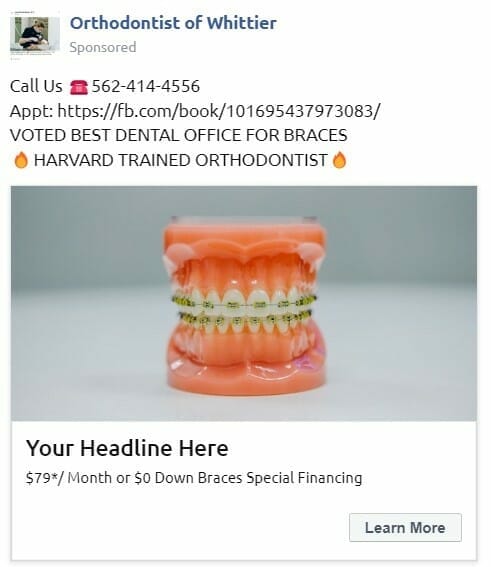Are you an orthodontist looking to grow your practice? Look no further! In this article, we will explore how you can boost your orthodontic practice with Facebook ads. With the increasing presence of social media in today’s society, leveraging the power of platforms like Facebook can greatly benefit your business. We will discuss the benefits of using Facebook ads to reach potential patients, how to create effective ad campaigns, and tips for optimizing your ads for maximum results. By the end, you’ll be equipped with the knowledge and tools to effectively use Facebook ads to expand your orthodontic practice.
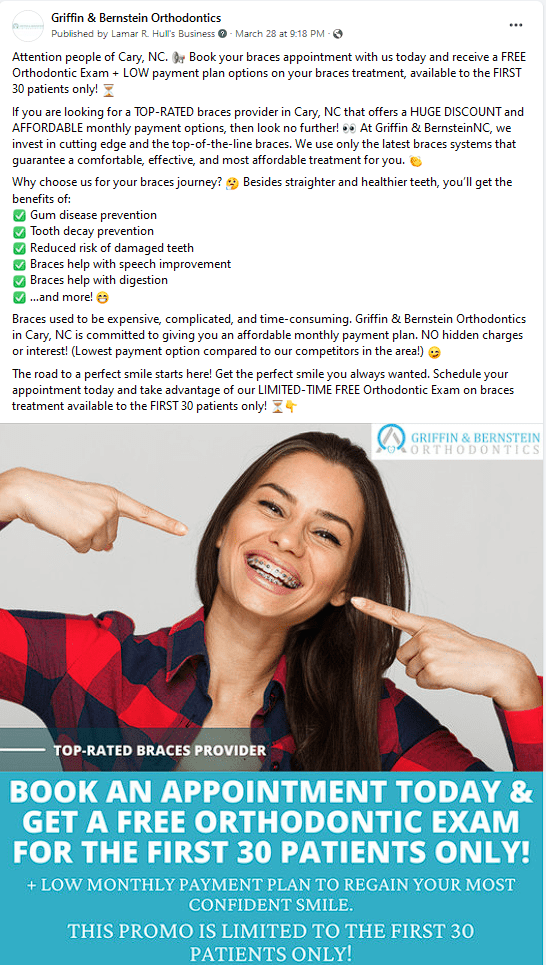
Increase Your Orthodontic Practice’s Success With Facebook Ads
1. Understanding the Potential of Facebook Ads for Orthodontic Practices
Facebook Ads have become a powerful tool for businesses to reach their target audience effectively. In the case of orthodontic practices, Facebook Ads provide a unique opportunity to connect with potential patients and raise awareness about the services offered. But why should orthodontic practices consider using Facebook Ads?
1.1 Why Facebook Ads?
Facebook has over 2.8 billion active monthly users, making it the largest social media platform globally. With such a vast user base, Facebook offers orthodontic practices the ability to reach a wide range of individuals who may be interested in their services. By utilizing Facebook Ads, orthodontic practices can tap into this large user base and connect with potential patients in a cost-effective manner.
Furthermore, Facebook Ads allow orthodontic practices to target their ads with precision. Through Facebook’s advanced targeting options, ads can be tailored to reach specific demographics, interests, and behaviors, ensuring that they are seen by the right audience. This level of targeting can significantly increase the effectiveness of the ad campaigns and drive better results.
1.2 Benefits of Using Facebook Ads for Orthodontic Practices
There are several key benefits that orthodontic practices can enjoy by utilizing Facebook Ads:
-
Increased Brand Awareness: Facebook Ads can help orthodontic practices increase their brand visibility and reach a broader audience. By consistently exposing potential patients to your brand and services, you can establish trust and recognition, making it more likely for them to choose your practice for their orthodontic needs.
-
Targeted Reach: With Facebook’s targeting options, orthodontic practices can ensure that their ads are seen by individuals who are more likely to be interested in orthodontic treatment. This level of precision targeting helps to maximize the ROI of ad campaigns and ensures that resources are allocated towards reaching the most relevant audience.
-
Cost-Effective Advertising: Compared to traditional advertising methods, Facebook Ads offer a cost-effective solution for orthodontic practices. With the ability to set a specific budget, practices can control their advertising expenses and optimize their campaigns based on the results they achieve.
-
Enhanced Engagement: Facebook Ads allow orthodontic practices to engage with potential patients in a more interactive way. By utilizing engaging ad copy, visuals, and call-to-actions, practices can create a meaningful connection with their target audience and encourage them to take action, such as booking an appointment or visiting their website.
-
Measurable Results: Facebook Ads provide robust analytics and reporting features that allow orthodontic practices to measure the performance of their campaigns. By monitoring key metrics and analyzing the data, practices can gain insights into what works best and make data-driven adjustments to optimize their advertising efforts.
2. Setting Up a Successful Facebook Ad Campaign
To maximize the potential of Facebook Ads for orthodontic practices, it is essential to set up a successful ad campaign. Here are the key steps to follow:
2.1 Defining Your Target Audience
Before launching a Facebook Ad campaign, orthodontic practices need to define their target audience. Who are the individuals most likely to be interested in their services? By understanding the demographics, interests, and behaviors of their ideal patients, practices can fine-tune their targeting options on Facebook and ensure that their ads are seen by the right people.
For example, an orthodontic practice may want to target parents or individuals within a specific age range who reside in a particular geographical area. By narrowing down the target audience, practices can increase the relevance of their ads and improve the overall campaign performance.
2.2 Creating Engaging Ad Copy and Visuals
To capture the attention of potential patients on Facebook, orthodontic practices must create engaging ad copy and visuals. The ad copy should clearly communicate the unique selling propositions of the practice, such as advanced orthodontic techniques or exceptional patient care. It should also include a compelling call-to-action that encourages users to take the desired action, such as booking a consultation.
Accompanying the ad copy, visually appealing and eye-catching graphics or videos can further enhance the effectiveness of the ads. Images of happy patients with beautiful smiles or before-and-after transformations can create an emotional connection and reinforce the value of orthodontic treatment.
2.3 Selecting the Right Objective
When setting up a Facebook Ad campaign, orthodontic practices need to select the right objective based on their marketing goals. Facebook offers a variety of objectives, such as brand awareness, reach, engagement, traffic, and conversions. The objective should align with the desired outcome of the ad campaign.
For example, if the goal is to drive more traffic to the practice’s website and encourage potential patients to schedule an appointment, the “Traffic” objective would be suitable. On the other hand, if the primary goal is to create awareness about a special promotion, the “Reach” objective may be more appropriate.
2.4 Budgeting and Scheduling
Orthodontic practices should establish a clear budget for their Facebook Ad campaign to ensure that resources are allocated effectively. The budget should take into account factors such as the desired ad reach, campaign duration, and the competitiveness of the targeted audience.
Facebook provides options for both daily and lifetime budgets. A daily budget sets a specific amount to be spent on the campaign each day, while a lifetime budget allows for more control over budget distribution throughout the duration of the campaign.
Additionally, practices should consider scheduling their ads to run during specific days and times when their target audience is most likely to be active on Facebook. By optimizing the ad schedule, practices can maximize the visibility and impact of their ads.
2.5 Choosing Ad Placements
Facebook offers various ad placement options, including the News Feed, Instagram, Messenger, and the Audience Network. Orthodontic practices should carefully consider which ad placements are most relevant to their target audience and align with their campaign goals.
For example, if the target audience consists primarily of parents who spend time scrolling through the News Feed, placing ads in the News Feed may yield better results. If the practice wants to reach a younger demographic, utilizing ad placements on Instagram or Messenger could be more effective.
By strategically selecting ad placements, orthodontic practices can ensure that their ads appear in front of the right people at the right time, improving the overall campaign performance.
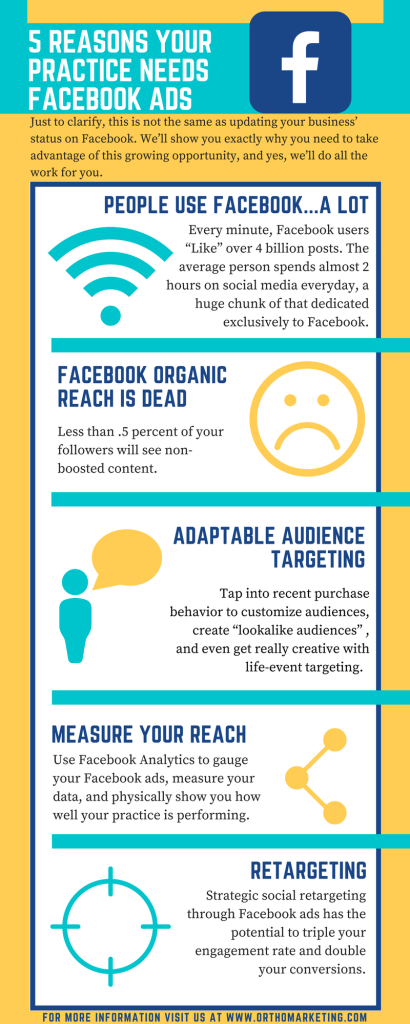
Supercharge Your Orthodontic Business With Facebook Ads
3. Utilizing Facebook’s Targeting Options
Facebook provides a range of targeting options that allow orthodontic practices to narrow down their audience and reach individuals who are most likely to be interested in their services. Here are some key targeting options to consider:
3.1 Geographical Targeting
Orthodontic practices are typically limited to a specific geographical area due to their physical location. With Facebook’s geographical targeting, practices can specify the locations they want to target, such as a particular city, state, or a radius around their practice.
By focusing their ad campaigns on these specific geographical areas, orthodontic practices can ensure that their ads are seen by individuals who are within a reasonable distance and are more likely to become potential patients.
3.2 Demographic Targeting
Demographic targeting allows orthodontic practices to narrow down their audience based on specific demographic characteristics. These characteristics may include age, gender, education, employment, and more.
For example, if an orthodontic practice specializes in treatments for adults, they can target individuals within a certain age range to ensure that the ads reach the intended audience. On the other hand, if the practice offers orthodontic services for teenagers, targeting parents of teenagers may be more appropriate.
3.3 Interest-Based Targeting
Facebook allows advertisers to target individuals based on their interests, hobbies, and activities. Orthodontic practices can utilize interest-based targeting to reach individuals who have expressed an interest in oral health, dental care, or specific related topics.
By identifying relevant interests and incorporating them into the targeting options, orthodontic practices can ensure that their ads are shown to individuals who have demonstrated an affinity for topics related to their services. This increases the likelihood of capturing the attention of potential patients who may be actively seeking orthodontic treatment.
3.4 Behavioral Targeting
Behavioral targeting focuses on reaching individuals based on their online behaviors and activities. Facebook collects data on users’ behavior, such as their online shopping habits, device usage, travel patterns, and more. Orthodontic practices can leverage this behavioral data to target individuals who have shown behaviors or interests relevant to their services.
For example, practices can target individuals who have recently searched for orthodontic treatments or have visited dental websites. By focusing their ads on individuals who have shown a specific behavior, orthodontic practices can narrow down their audience and increase the relevance of their ads.
3.5 Custom Audience Targeting
Custom audience targeting allows orthodontic practices to reach users who are already familiar with their practice. Practices can create custom audiences by uploading their existing patient lists, website visitors, or individuals who have engaged with their Facebook Page or posts.
Targeting custom audiences can help orthodontic practices nurture existing relationships and encourage repeat visits or referrals. By delivering tailored messages to their custom audiences, practices can stay top-of-mind and strengthen the bond with their current patients.
4. Designing Effective Landing Pages
While Facebook Ads are crucial in capturing the attention of potential patients, the effectiveness of the ads can be significantly amplified by designing effective landing pages. Here are some key considerations for designing landing pages that convert:
4.1 Importance of Landing Pages in Facebook Ad Campaigns
Landing pages play a critical role in the success of Facebook Ad campaigns. When users click on an ad, they expect to be directed to a landing page that provides relevant and specific information about the offer or promotion mentioned in the ad.
By designing landing pages that align with the messaging and visuals of the Facebook ads, orthodontic practices can provide a seamless and cohesive user experience. This alignment can enhance trust and credibility and increase the likelihood of users taking the desired action, such as booking an appointment or contacting the practice.
4.2 Elements of a High-Converting Landing Page
A high-converting landing page should have several key elements:
-
Clear and Concise Headline: The headline of the landing page should clearly communicate the unique value proposition or offer presented in the ad. It should capture the attention of the user and entice them to explore further.
-
Compelling Visuals: Including captivating images or videos on the landing page can help reinforce the messaging and create a visual connection with the user. It is essential to use visuals that are relevant to the ad and resonate with the target audience.
-
Informative and Persuasive Content: The content on the landing page should provide users with relevant information about the orthodontic practice, its services, and the benefits of choosing the practice for their orthodontic needs. It should address potential concerns or questions users may have and highlight what sets the practice apart from competitors.
-
Clear Call-to-Action: The landing page should feature a clear and prominent call-to-action (CTA) that prompts users to take the desired action. Whether it’s filling out a contact form, calling the practice, or booking an appointment online, the CTA should be easily visible and straightforward.
4.3 Using Compelling Call-to-Actions
The call-to-action (CTA) used on the landing page plays a vital role in encouraging users to take the desired action. Orthodontic practices should craft compelling CTAs that create a sense of urgency or highlight the benefits of taking action.
For example, CTAs such as “Schedule Your Free Consultation Today” or “Unlock Your Perfect Smile Now” can motivate users to take immediate action. By utilizing action-oriented language and offering a clear benefit, orthodontic practices can increase the conversion rates of their landing pages.
4.4 Optimizing Landing Pages for Mobile
With a significant portion of Facebook users accessing the platform via mobile devices, it is crucial for orthodontic practices to optimize their landing pages for mobile responsiveness. Mobile-optimized landing pages ensure a seamless user experience regardless of the device used.
The landing page should load quickly on mobile devices, have easily readable text, and have a responsive design that adapts to different screen sizes. By prioritizing mobile optimization, orthodontic practices can cater to the preferences of their target audience and maximize the conversion potential of their landing pages.
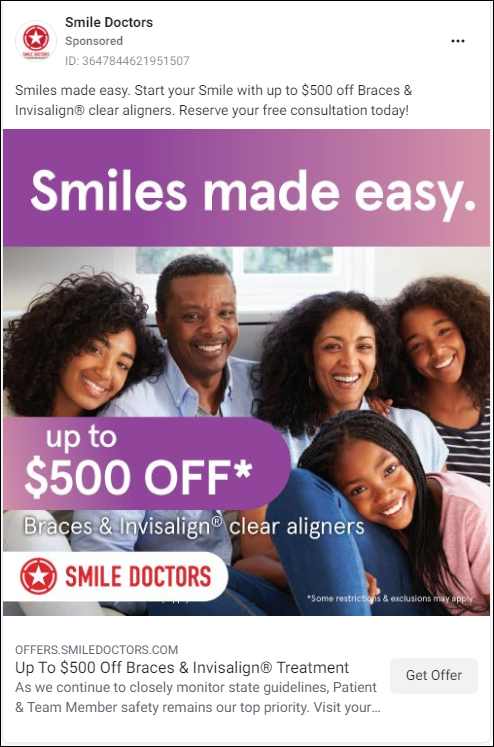
5. A/B Testing and Optimization
To ensure the success of Facebook Ad campaigns, orthodontic practices should embrace A/B testing and optimization strategies. Here’s why it matters:
5.1 The Importance of A/B Testing
A/B testing involves creating multiple variations of ads or landing pages and testing them simultaneously to determine which variation performs better. By conducting A/B tests, orthodontic practices can identify what elements, such as ad copy, visuals, headlines, or CTAs, resonate most effectively with their target audience.
By testing different combinations of elements, orthodontic practices can continuously improve their ad campaigns and uncover insights that drive better results. A/B testing helps practices make data-driven decisions and allocate their resources towards the most effective variants.
5.2 Key Metrics to Monitor and Analyze
When optimizing Facebook Ad campaigns, orthodontic practices should closely monitor and analyze key metrics to assess the performance and effectiveness of their campaigns. Some important metrics to consider include:
-
Click-Through Rate (CTR): CTR measures the percentage of users who clicked on the ad after seeing it. A high CTR indicates that the ad copy, visuals, and targeting are resonating well with the audience.
-
Conversion Rate: Conversion rate measures the percentage of users who took the desired action, such as booking an appointment or filling out a contact form, after clicking on the ad. A high conversion rate indicates that the landing page is effective in motivating users to take action.
-
Cost per Conversion: Cost per conversion measures how much an orthodontic practice pays for each desired action taken by users. By optimizing the cost per conversion, practices can ensure that their ad campaigns are cost-effective and efficient.
By monitoring these metrics, orthodontic practices can gain insights into the strengths and weaknesses of their campaigns and make data-driven decisions to improve performance.
5.3 Iterative Optimization Strategies
Optimizing Facebook Ad campaigns is an iterative process. Orthodontic practices should continuously evaluate the performance of their campaigns and make strategic adjustments based on the data collected.
For example, if an ad campaign is not generating the desired results, practices can experiment with different variations of ad copy, visuals, or targeting options. By evaluating the performance of these variations and comparing them to the original, practices can identify which elements drive better results and make adjustments accordingly.
It is crucial to give each variation sufficient time for data collection to ensure statistically significant results. By following an iterative optimization approach, orthodontic practices can maximize the effectiveness of their Facebook Ad campaigns and continuously improve their results over time.
5.4 Implementing Remarketing Campaigns
Remarketing campaigns offer orthodontic practices the opportunity to re-engage with individuals who have previously interacted with their ads or visited their website. By utilizing Facebook’s custom audience targeting options, practices can create tailored ads specific to these remarketing audiences and bring them back into the sales funnel.
Remarketing campaigns can be highly effective in nurturing the relationship with potential patients who may need more time to make a decision. By delivering targeted ads to these remarketing audiences, orthodontic practices can reinforce their value proposition and increase the likelihood of converting leads into patients.
6. Leveraging Retargeting to Maximize Conversion Rates
One powerful strategy that orthodontic practices can employ is retargeting, which involves reaching out to users who have previously shown interest in their practice. Here’s how retargeting can maximize conversion rates:
6.1 Introduction to Retargeting
Retargeting allows orthodontic practices to reach and engage users who have already interacted with their Facebook ads, visited their website, or engaged with their social media content. By retargeting these users with specific ads, practices can reinforce their message and encourage them to take the desired action.
Retargeting can be a valuable strategy because it focuses on individuals who have already shown some level of interest in the practice, making them more likely to convert into patients. By reminding them of the practice’s services or presenting them with an exclusive offer, orthodontic practices can increase the chances of converting these warm leads.
6.2 Benefits of Retargeting for Orthodontic Practices
Retargeting offers several benefits for orthodontic practices:
Greater Conversion Rates: Retargeting allows practices to focus on individuals who have already expressed interest, increasing the likelihood of conversion. By delivering personalized and relevant ads to these users, practices can maintain their presence and remind them of the value of orthodontic treatment.
Enhanced Brand Recall: By repeatedly exposing potential patients to the practice’s ads, retargeting helps build brand recall. Even if users don’t convert immediately, the ongoing reminders can keep the practice top-of-mind, making them more likely to choose the practice when the need arises.
Cost-Effective Strategy: Retargeting can be a cost-effective advertising strategy because it focuses on a specific audience. Practices can allocate their resources towards reaching warm leads rather than casting a wide net and spending their budget on individuals who may have little interest in orthodontic treatment.
6.3 Creating Custom Audiences for Retargeting
To implement retargeting strategies, orthodontic practices can create custom audiences based on various criteria. These include website visitors, users who have engaged with specific Facebook posts, or individuals who have reached a certain stage in the sales funnel.
By creating custom audiences, practices can deliver tailored ads to individuals who have already shown a level of interest. For example, if a user has visited the practice’s website and browsed specific orthodontic treatment pages, the custom audience can be set up to target these users with ads related to those treatments.
6.4 Crafting Compelling Ad Content for Retargeting
When crafting ad content for retargeting, orthodontic practices should consider the stage of the sales funnel the users are in. Users who have already shown interest and engaged with the practice may require different messaging compared to those who are being introduced to the practice for the first time.
For example, retargeting ads can focus on highlighting the practice’s unique selling propositions, such as testimonials from satisfied patients or information about the expertise of the orthodontist. Special offers or promotions can also be utilized to entice users to take action.
By tailoring the ad content to the retargeting audience, orthodontic practices can maximize the conversion potential and increase the effectiveness of their retargeting efforts.
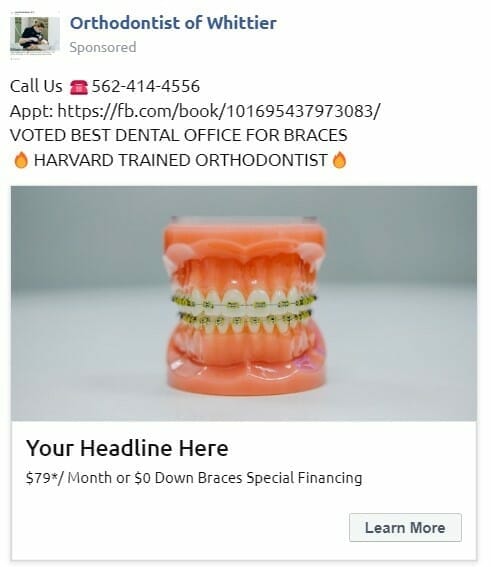
7. Enhancing Ad Performance with Analytical Tools
Analytical tools play a crucial role in optimizing the performance of Facebook Ad campaigns. By utilizing these tools, orthodontic practices can gain valuable insights and make data-driven decisions. Here’s how it can be done:
7.1 Importance of Analytics in Facebook Ad Campaigns
Analytical tools provide orthodontic practices with valuable data and insights about the performance of their Facebook Ad campaigns. By regularly monitoring and analyzing these metrics, practices can evaluate the effectiveness of their campaigns, identify areas for improvement, and make informed decisions to optimize their advertising efforts.
7.2 Facebook Ads Manager
Facebook Ads Manager is a powerful tool that allows orthodontic practices to manage and monitor their ad campaigns. It provides an intuitive interface where practices can track key metrics, such as impressions, reach, engagement, and conversions.
Through Facebook Ads Manager, practices can access detailed reports and analytics, create custom audiences, set budgets and schedules, and make adjustments to their ad campaigns in real-time. Utilizing the features of Facebook Ads Manager, orthodontic practices can streamline their advertising processes and enhance the performance of their campaigns.
7.3 Conversion Tracking
Conversion tracking allows orthodontic practices to measure the effectiveness of their Facebook Ad campaigns in driving specific actions, such as appointment bookings or form submissions. By implementing conversion tracking, practices can determine which ads or ad variants are generating the most conversions and optimize their campaigns accordingly.
Facebook provides a conversion tracking tool that can be set up by adding a conversion pixel or using the Facebook pixel. Practices can customize the conversion tracking based on the actions they consider valuable, such as completed forms or downloads.
7.4 Pixel Tracking for User Behavior Analysis
Facebook pixel is a tracking code that can be placed on a practice’s website to collect data on user behavior and actions taken after clicking on a Facebook ad. By utilizing pixel tracking, orthodontic practices can gain insights into how users interact with their website content, navigate through their pages, and perform specific actions.
The data collected through pixel tracking can be used to optimize ad campaigns, retarget users based on their website behavior, and create lookalike audiences to reach new potential patients. By analyzing the pixel data, orthodontic practices can uncover trends and patterns that inform their marketing strategies and drive better results.
8. Ensuring Legal Compliance and Ethical Advertising Practices
Orthodontic practices must ensure legal compliance and promote ethical advertising practices when utilizing Facebook Ads. Here are some key considerations:
8.1 Adhering to HIPAA Regulations
Orthodontic practices should prioritize patient privacy and comply with the Health Insurance Portability and Accountability Act (HIPAA) regulations when collecting and utilizing personal information. Any data collected through Facebook Ads should be handled in a secure and confidential manner, following HIPAA guidelines.
Practices should clearly communicate their commitment to privacy and confidentiality in their ad copy and landing pages. This reassures potential patients that their information will be handled responsibly and reinforces the practice’s commitment to ethical practices.
8.2 Maintaining Privacy and Confidentiality
Apart from complying with HIPAA regulations, orthodontic practices should also take additional steps to maintain privacy and confidentiality when utilizing Facebook Ads. This includes secure data management, ensuring the protection of user information, and using appropriate encryption methods.
Practices should clearly communicate their privacy policy and provide a link to it on their landing pages or website. Transparency about data handling practices helps build trust with potential patients and reinforces the ethical principles of the practice.
8.3 Transparent and Honorable Marketing Strategies
Orthodontic practices should uphold transparent and honorable marketing strategies when using Facebook Ads. This includes avoiding misleading or exaggerated claims, providing accurate information about services and prices, and delivering on promises made in the ad messages.
By promoting ethical advertising practices, orthodontic practices can build credibility and trust with potential patients. This, in turn, increases the likelihood of prospective patients choosing their practice over competitors.
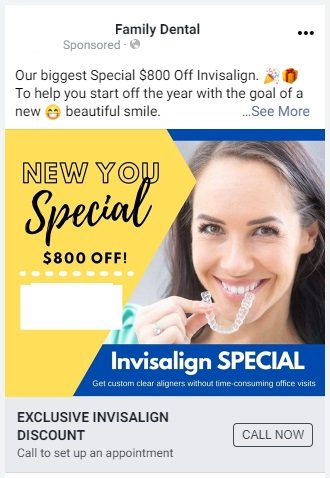
9. Monitoring and Adjusting Campaign Performance
Monitoring the performance of Facebook Ad campaigns is crucial to identify areas for improvement and make data-driven adjustments. Here’s how orthodontic practices can effectively monitor and adjust campaign performance:
9.1 Regular Performance Monitoring
Orthodontic practices should regularly monitor the performance of their Facebook Ad campaigns to evaluate the effectiveness of their ads and assess the return on investment. This includes monitoring key metrics such as click-through rates, conversion rates, and cost per conversion.
By consistently monitoring performance, practices can identify trends, spot any issues or underperforming campaigns, and take proactive steps to address them. Regular performance monitoring is essential in ensuring that ad campaigns are on track and generating the desired results.
9.2 Tracking Key Performance Indicators (KPIs)
Key Performance Indicators (KPIs) serve as benchmarks for measuring the success of Facebook Ad campaigns. Orthodontic practices should establish relevant KPIs based on their campaign goals and regularly track them to assess performance.
Common KPIs for Facebook Ad campaigns may include click-through rates, conversion rates, cost per conversion, leads generated, or return on ad spend. By setting specific KPIs and tracking their progress, practices can determine the effectiveness of their campaigns and make data-driven decisions for optimization.
9.3 Making Data-Driven Adjustments
Data-driven adjustments are essential in optimizing Facebook Ad campaigns for orthodontic practices. By analyzing the performance data collected, practices can identify areas that require improvement and make informed decisions to optimize their campaigns.
For example, if certain ads are generating a higher click-through rate but a lower conversion rate, practices can experiment with different landing page variations to improve the conversion rates. By testing and analyzing the performance of different variations, practices can make data-driven adjustments that drive better results.
9.4 Continuous Campaign Optimization
Facebook Ad campaigns for orthodontic practices should be viewed as an ongoing process of optimization. Practices should continuously evaluate the performance of their campaigns, adjust targeting options, refine ad copy and visuals, and optimize landing pages to improve conversion rates.
By embracing a culture of continuous optimization, orthodontic practices can ensure that their Facebook Ad campaigns consistently evolve to meet the changing needs of their target audience. Regular assessment and adjustment contribute to long-term success and help practices stay ahead of the competition.
10. Case Studies and Success Stories
To gain further insights into the potential of Facebook Ads for orthodontic practices, let’s explore some real-life examples of successful campaigns:
10.1 Real-Life Examples of Successful Orthodontic Facebook Ad Campaigns
-
Orthodontic Practice A launched a Facebook Ad campaign targeting parents of teenagers in their locality. By utilizing engaging visuals of teenagers with braces and highlighting the benefits of early orthodontic treatment, the campaign generated a high click-through rate and significant conversions. The practice experienced a notable increase in appointment bookings and parent inquiries.
-
Orthodontic Practice B aimed to raise awareness about their new Invisalign treatment option. They created a Facebook Ad campaign that targeted adults in their city who had expressed an interest in cosmetic dentistry. By offering a limited-time discount and emphasizing the benefits of Invisalign, the campaign generated high engagement and conversion rates. Practice B successfully attracted new patients seeking discreet orthodontic treatment.
10.2 Lessons Learned from Case Studies
These case studies highlight some essential lessons for orthodontic practices considering Facebook Ads:
-
Tailor Ads to the Target Audience: By understanding the interests and needs of the target audience, practices can create ads that resonate with potential patients. Tailoring ad copy, visuals, and offers to the target audience increases relevance and enhances the effectiveness of the campaigns.
-
Call-to-Actions and Special Offers Drive Results: By incorporating compelling call-to-actions and exclusive promotions, orthodontic practices can incentivize potential patients to take action. Clear CTAs that create a sense of urgency or highlight the benefits of choosing the practice can significantly impact conversion rates.
-
Continual Optimization Yields Results: Successful Facebook Ad campaigns require ongoing optimization. By regularly monitoring performance, testing variations, and making data-driven adjustments, orthodontic practices can maximize the effectiveness of their campaigns and continually improve results.
By carefully analyzing these case studies, orthodontic practices can gain valuable insights into effective strategies and techniques to implement in their Facebook Ad campaigns.
In conclusion, harnessing the potential of Facebook Ads can greatly benefit orthodontic practices. By understanding the importance of Facebook Ads, setting up successful campaigns, utilizing targeting options, designing effective landing pages, conducting A/B testing, leveraging retargeting, utilizing analytical tools, adhering to legal regulations, and continuously monitoring and adjusting campaign performance, orthodontic practices can maximize their reach, engage with potential patients, and achieve exceptional results. Facebook Ads offer an effective and cost-efficient way for orthodontic practices to boost their visibility, establish their brand, and attract new patients.
Maximize Your Orthodontic Practice’s Growth Through Facebook Ads

